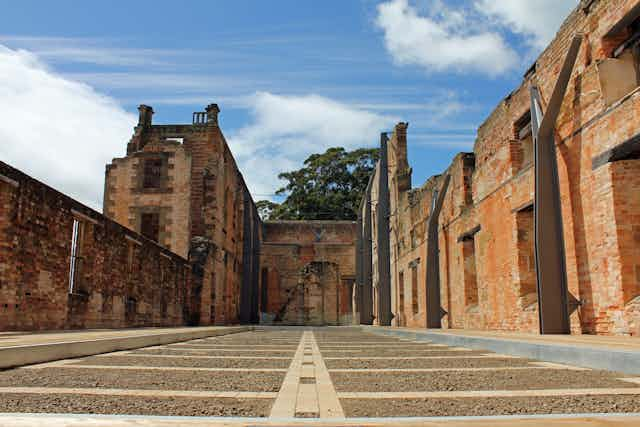Many Australians wish for nothing more than to forget Martin Bryant, the perpetrator of the Port Arthur massacre. Others insist that remembering both Bryant and the massacre is necessary if a proper reckoning is to be made with the events of April 28, 1996.
No matter where you stand, this is an important debate. How Bryant and, more importantly, the dead and survivors of the massacre are remembered is vital if we’re to appreciate the impact of it.
The scale of the atrocity, the enigma of the perpetrator, the mystique of the setting, the dramatic public consequences, and local protocols for referencing the event and the murderer have, in different measures, traumatised and gripped many in Australia and beyond.
They’ve also served a series of myths about the massacre and the murderer. Common to many renditions of the story is the idea that the national psyche and identity were violently altered by Bryant’s vicious rampage. Indeed, the event’s power over the nation is such, it is often claimed, that the story of that day demands constant retelling.
Looking at a monster
Consider the recent episode of Channel 7’s weekly current affairs program, Sunday Night. Martin Bryant: the Interview (March 6, 2016) opens with a dramatic montage of images and statements emphasising Bryant’s demonic nature.
Acknowledging “Australia was scarred forever by the horrors at Port Arthur 20 years ago,” the program promises “unseen” video footage of Bryant’s police interviews that supposedly provide insight into the murderer’s grip over the popular consciousness.
The health of the national psyche is again invoked to justify a planned film about the massacre. Of his proposed venture, Bryant — The Port Arthur Massacre, producer Paul Moder is quoted as saying it will be “balanced and respectful” while nevertheless “hard hitting … very confronting and … horrific.”
Responding to the – understandable – lack of support from survivors of the massacre, Moder apparently complains:
I am being warned off by those sympathetic to the desire by many to bury the event in Australia’s collective memory.
Every retelling of a catastrophic event includes certain elements while excluding others. But retelling the unfolding of the massacre with the focus strongly on Bryant and the “national psyche” risks sensationalising the murderer as the epitome of evil. Rendering the story as a gothic drama risks marginalising the voices of actual victims and survivors.
A different view
Other examples of retelling the Port Arthur massacre go some way to rectifying this. And, in doing so, they remind us that there’s no single story here.
Earlier this month, the ABC’s Australian Story series presented an episode on Port Arthur. It focused on stories of the suffering and resilience of people who were at the massacre, such as Carolyn Loughton.
Loughton was visiting Port Arthur with her 15-year-old daughter Sarah when Bryant attacked people in the Broad Arrow Café. Carolyn survived; Sarah was killed.
Bryant certainly features in the story. But the primary focus is stories of those who died and those who survived, witnessing the shooting and its aftermath, as well as those who helped them. Here the themes of solidarity and of community fashioned in response to the atrocity prevail.
In its retelling of the Port Arthur massacre, Australian Story downplays the significance of the event in the national psyche while accentuating the theme of “compassionate citizenship.”
It returns constantly to the reactions of those who found themselves under fire, those who attended to the dead and the wounded, and those who sought to change gun laws in the wake of the disaster.
Viewer attention is directed away from the menace and the mystery of Bryant. Instead, his victims are presented as active and central. And they invite a compassionate response.
Understanding history
The theme of compassionate citizenship is evident in other representations of the massacre. In works such as Port Arthur and Port Arthur triptych, artist Rodney Pople brings together images of the historic site’s convict and indigenous pasts, as well as acknowledging Martin Bryant and his actions.
Pople links the history of violence associated with Port Arthur to the European invasion of Tasmania. His paintings create a confronting sense of empathetic unsettlement in the viewer.
In their deployment of images of Bryant, Pople’s re-visionings of the Port Arthur massacre invite reflection on those other Australians, specifically Tasmanian Aboriginals, who’ve been subjected repeatedly to acts of indiscriminate and brutal violence.
The retelling of the Port Arthur massacre in Pople’s work and Australian Story seek to reframe what happened 20 years ago. But they are not without their limitations. Like other stories of what happened at Port Arthur 20 years ago, they remain partial and incomplete.
Still, they try to refashion the memory of the massacre and invite audiences to shift their focus from Bryant and idealistic notions of a national psyche or identity that prevail in other accounts.
They challenge us to renew our understanding of the impact of the event on the victims and survivors. And they place the story of Port Arthur within a broader context of the history of violence in Australia, and of our responses to it.
This article is part of a package marking the 20th anniversary of the 1996 Port Arthur massacre.

